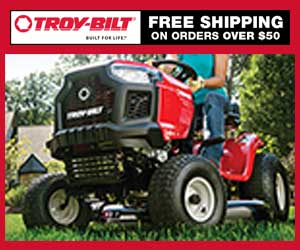
by Martin Collins
Equestrians will agree, when it comes to arena riding, a well-appointed ring is a joy to work (and play!) in. The footing you choose for your enclosure will depend on a variety of factors and will be the most important component of a well-designed and properly constructed riding area.
In this article, Glynnie Walford of Martin Collins© Equine Surfaces provides the information you need to create a first-rate surface for all of your equine endeavors.
Building Your Arena’s Foundation
Next to the footing, the base is the most important part of your arena, and often something that gets overlooked during construction. Here are a few things to consider before starting any new construction.
Cut and Fill
Cut and Fill is the process of cutting into a bank and re-laying the material lower down the bank to create a “level formation” for your outdoor equine arena. The banks/ slopes must be created correctly to support the new formation.
The more level the site, the less cost will be involved in the initial stages of construction.
Build at the Right Time of Year
The best time to build a new arena is during a dry period, preferably in the late spring/summer early fall. This will make for less disruption and a cleaner site with which to work. It will also be easier for trucks delivering aggregate etc. to drive onto the property with good ground conditions.
Various types of sub soil need to be taken into consideration: Clay in particular needs to be carefully managed, especially during earthworks such as “cut and fill,” so “clay heave” does not occur. (This is most likely to occur when the clay is wet and under pressure, which causes it to “bubble up.”
This can move the stone layer and membranes, leading to contamination of the surface and poor drainage. Should this occur, remedial works will be necessary.)
A sheltered spot is preferable, however, watch for trees and construct away from roots. Be mindful of leaf contamination in the fall as these will need to be removed because if left, they will rot and contaminate the footing.
If you are forced to construct on an exposed site, be wary of the footing you choose so as not to lose it during windy weather!
Keep away from utilities and obstructions that may be costly to move.
If the arena is situated any distance from the barn, ensure that you plan for an approach ‘track’ so that no debris is taken into the new footing by the hooves of horses and also maintenance equipment. This can be of a similar surface to the arena or an aggregate.

Pay Attention to Drainage
Internal drains should be spaced every 30 feet linking into a perimeter and then to outfalls to take surface water away. This is generic and will alter dependent upon the type of sub soil under the construction location.
If the ground is heavy clay, additional cross drains may be required and the diameter of the exterior drains may have to be increased.
It is important that the drain runs have a consistent fall. Ensure drainage trenches are backfilled with clean drainage gravel with no fines or dust content as this can block the trenches over a period of time.
The tops of all the trenches and overall arena should be covered with a fine grade (e.g. 4 oz.) non-woven geotextile membrane. This acts as a separator between the earth and clean stone layer. This will allow the water to pass in to the drains, but will prevent silt/ sediment from doing the same.
It is important to include drainage trenches on the outside of the arena. These external drains will stop the “run off” from adjacent paddocks – so this is especially important if an arena has been cut into the slope. They are also important because the outside track typically has the heaviest “foot fall.”
Use Quality Stone for your Base
The types of stone used do vary from state to state but as a generic for those states that experience low temperatures in the winter: For the base layer (stone drainage layer), it is VITAL that clean, hard, angular stone is used. Hard: means the stones are frost resistant, i.e. will not break down after successive winters or fracture due to the weight of maintenance machinery.
The quarry can provide ‘technical data sheets’ if in any doubt. An indicator test: Take two stones and bang them together, they should not dust, crack or break. If they do, they are not frost resistant.
Angular stones must inter-link together, so they need to be of similar size, typically 1 ¾” to 2 ¾”. (If the stone is rounded it will never “knit” together, so the surface will never be correctly compacted if the base layer moves.)
Clean: means the stone has been washed so stone dust/ fine soil is not washed straight in to your drains, causing reduced flow of surplus water. The stone layer should be 4” compacted depth when laid (dependent upon type of sub-soil), ideally the stone layer should extend 20” beyond the fence/ kick boards so the perimeter drain is laid outside the school.
Be cautious if your contractor does not specify the grade/ quantity or depth of the materials being laid. Clearly if less stone is used, it will be cheaper and some contractors will reduce the specification and price in order to win the work.
Choosing the Right Surface
Well-kept, ‘good going’ turf is the ideal surface for training and equestrian competitions; it is the traditional footing for all equestrian sports. However, in situations where turf cannot be sustained, all-weather surfaces for horses allow them to train and compete in different situations and weather conditions.
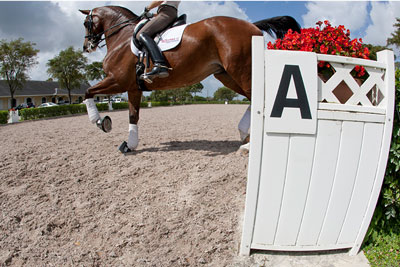
There are six main types of surfaces for horses available in the U.S. – fibers, sand/ mix, dirt, wood products, rubber, and coated (often referred to as all-weather).
These days PVC and rubber are less popular choices as they tend to “ride deep” in dry periods and disposal legislation is becoming restrictive; so structural fibers are becoming the norm.
* Coated Surfaces There are several types of coated equestrian surfaces that do not require irrigating however, ensure that you fully investigate the product you are interested in and take the opportunity of speaking to existing clients. This will give you the benefit of their knowledge of both riding and maintaining their rings. Check on the longevity of the coating and the rejuvenation process.
* Dry, Sand-Based Surfaces Dry, sand-based surfaces refer to equestrian surfaces made up of sand, mixed or topped with another material such as rubber or synthetic fibers. This addition of fibers to sand is becoming the most commonly used equestrian surface of the 21st century.
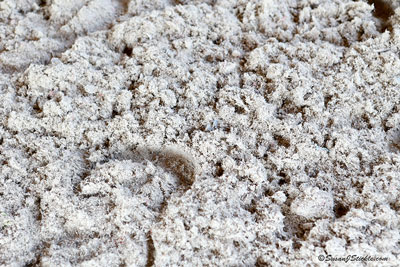
Upgrading Your Arena Surface
Extreme weather conditions inevitably put added pressure on your arena surface. Common problems are that surfaces become either too firm or too deep, and – in the case of sand-based surfaces – dry and dusty. If your surface is suffering, don’t automatically assume that it’s a case of facing the expense of entire replacement.
A complete overhaul is not always necessary (and certainly not always within an individual’s budget). Consider, instead surface enhancement, or refurbishment. Replacing the whole surface is, of course always an option. However, it is advisable to verify the condition of the underlying base. If the base is in need of remedial work this should be done before any replacement of surface, otherwise you will only be ‘throwing good money after bad’!
Care and Maintenance of Your Surface
The amount and type of arena grooming often depends on what type of surface you have. Some of the ‘dry’ surfaces require more water or grooming than others.
* Coated Surfaces
Coated riding surfaces are predominantly dust free (providing the manufacturer’s maintenance procedure is adhered to) and have a very good climactic tolerance and do not require an irrigation system. It is worth noting that Martin Collins wax coated synthetic horse riding surfaces are NOT coated with oils or petroleum jellies for two important reasons:
Some oils can wash through the surface and render the underlying base impervious. They are susceptible to melting in the warmer weather causing inconsistent ‘going’.
Neither oils nor petroleum jellies have the same lifespan as a wax-coated surface and will therefore require re-coating much sooner.
* Non-Coated
Non-coated riding surfaces require more maintenance than those with a wax coating. For optimum performance, an irrigation system is essential. Once a surface has dried out it can ride “deep” and can quickly become un-level. However, this can be rectified with specialized machinery.

Care advice for all synthetic riding surfaces
Martin Collins surfaces are sold to provide an average COMPACTED depth of approximately 4” when laid. Some others are sold UNCOMPACTED so, when laid, the depth can be reduced by 2″ (50mm). The following advice applies to all surfaces.
It is important that your new surface is kept both level and evenly compacted. If any hollows, dips or tracking appear, these should be corrected by hand raking prior to grooming the surface.
As previously mentioned, it is advisable to provide a clean approach to the arena to prevent both horses and maintenance equipment from bringing debris onto the footing and contaminating it.
When jumping fences should be moved frequently, and takeoff and landing pads hand raked before the stands are put away.
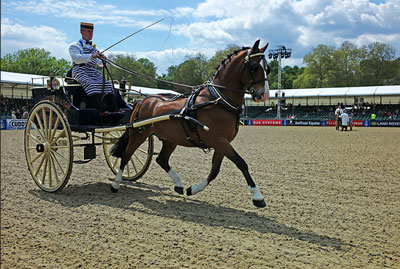
Making Your Riding Surface Last
The life span of a correctly installed and high performance riding surface will be determined by a range of factors. To protect your investment:
• Follow the manufacturer’s recommended maintenance guidelines.
• Lift all debris, horse droppings, leaf fall, etc.
• Carry out regular depth checks; these will immediately flag “dangerous” inconsistencies in overall depth i.e. 2” – 6”.
• Construct a track to the arena to keep horses’ feet and maintenance equipment clean when entering the arena.
The Size of the School
If you have a very small school, you may find the surface wears a little more quickly, as the horses are working “on the turn.” There is more pressure on the footing on turns, so lay additional depth for safety. The footing provider should assist and recommend the depth in such instances.
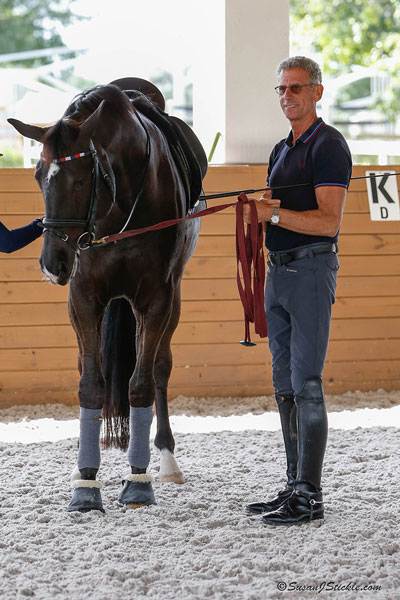
In Closing…
The above information is intended as a guide for those planning/ constructing a new riding surface or upgrading a pre-existing one. Remember, a thoughtful investment of time and finances now will ensure less time spent worrying about your arena – and more time enjoying it – for years to come.
North America’s premier equestrian footing experts, Martin Collins USA, have provided this important guide on arena material selection and construction. To learn more about Martin Collins surfaces, or to request a no-obligation quote, visit www.martincollinsusa.com.
You can also find Martin Collins Equine Services in the Footing section of our Barns & Stalls page.






